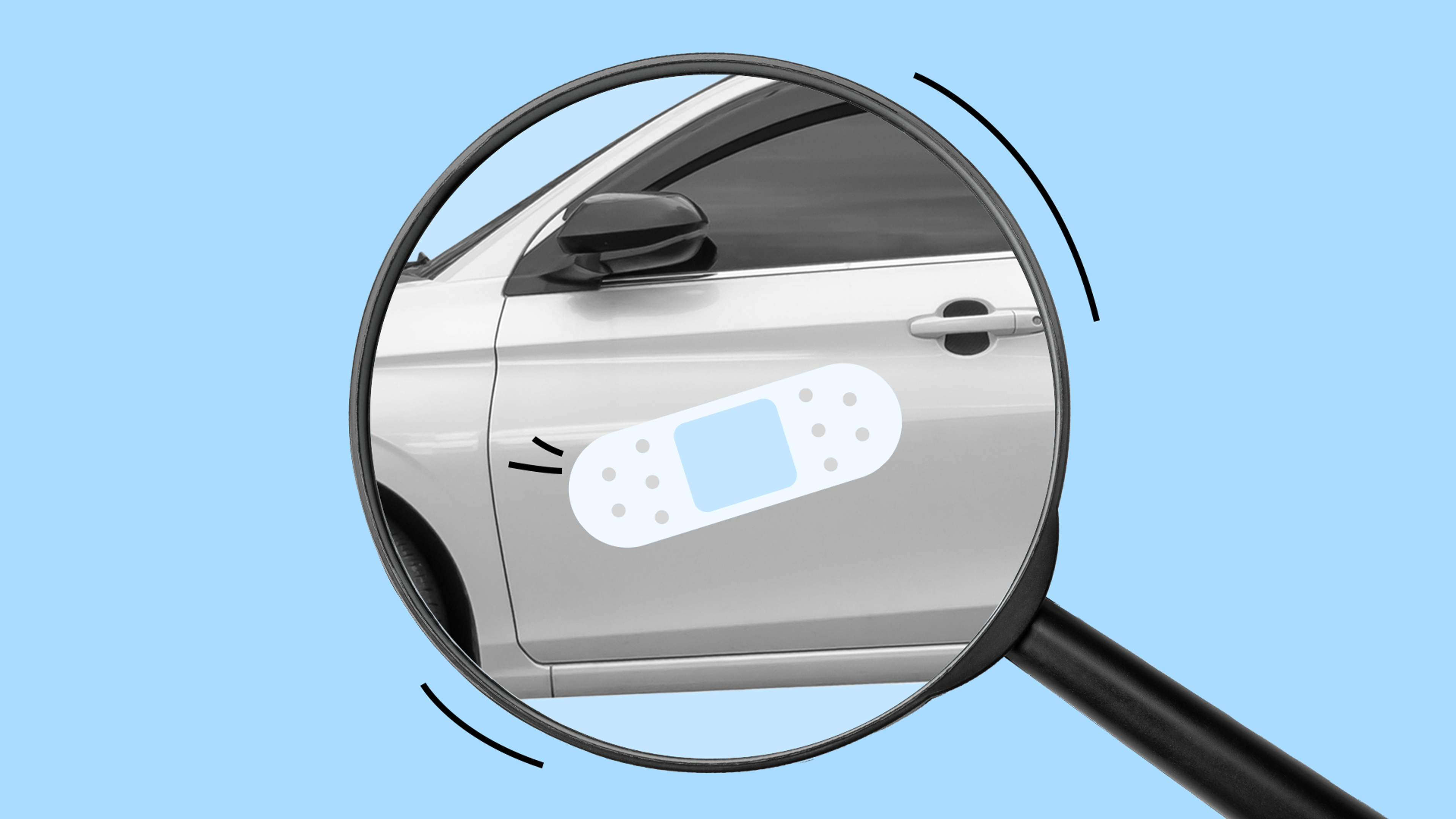05/12/2021
How to check if a car has been in an accident?

No one wants to buy a car that’s been in an accident. Especially if the seller has carefully covered it up and the truth only came out during a thorough investigation.
Thankfully, there are some ways to catch the scammer in the act. For example, the VIN number of each car allows access to a vehicle history report, which is without a doubt the simplest way to find out if the vehicle you’re interested in has been in a car accident.
However, a vehicle’s history report isn’t the only way to tell if it’s been damaged. There are other tricks buyers can use. So, if you want to widen your arsenal, read on. These tips will make you a pro at determining whether a car has been in an accident or has gone through an intense repair process.

Looks can be deceiving!
Don't risk your safety - check it with carVertical first
Look for easy to detect visual signs of an accident
When buying a used car, it is essential to keep in mind that every vehicle, no matter the manufacturing date, may have concealed problems caused by an accident impacting the vehicle’s structure.
While newer vehicles are usually well-made, cars below the small family vehicle class can have numerous flaws despite being in fine technical shape. Therefore, when looking for visual signs of an accident, buyers should consider the vehicle’s size and make.
1. Check for physical damage
Car body parts can offer the most reliable evidence that a vehicle was involved in an accident.
On both ends of the car, look for any cracks or patched places. Fenders and bumpers are easily shattered in a crash, since they are usually made of lightweight or plastic composite material. By moving your hands along the car, you can check for dents, cracks, and other damage.
Examine the wheels while inspecting the vehicle. A different tire or a more significant mark on the alloy wheel could be a sign. It’s also crucial to pay attention to the tire’s issue date. They can’t possibly be older than the vehicle.
2. Examine panel and door gaps
Build quality is one of the essential requirements when buying any car. For this very reason, people tend to buy an Audi or Mercedes-Benz, which can provide precision car assembly quality.
Uneven gaps between doors and the body panel next to them usually mean two things – poor build quality or the fact that a vehicle has been in a car accident.
At first, examine the spaces between the bonnet and the body panel next to it. The gaps should be straight and even in width from top to bottom.
Occasionally, misalignment here is due to poor quality management at the factory and has nothing to do with an accident. However, if the car in question is a brand known for its quality (e.g. a BMW), you should consider the possibility that the car has been damaged.
If you notice misalignment between the doors and the body panels or between the trunk and the rear wings, it’s possible the vehicle was repaired. The hood, doors, and trunk should be even with the other panels when closed. If they aren’t, that’s also a bad sign.
3. Look for signs of a bad paint-job
Inspect the condition of the vehicle’s paintwork in a clean, dry environment, preferably in broad daylight. Look for differences in the color of the paint on different parts of the body.
The presence of paint on the front wings usually indicates that there was a slight collision or scuff during normal operation. The same goes for the car doors – paint inconsistencies could mean a little scrape or serious damage.
It’s worth inspecting the paint thickness on the sills and look at the center pillars when open. In this area, there should be no paint residue.
Also, it is possible to determine which area of the car was painted by using a specific paint thickness measuring instrument:
- A vehicle with no accidents and original paintwork should have a reading of 80 - 120 microns.
- If a body part has been painted, the measuring instrument will read 150 - 260 microns.
- Anything greater than 300 microns should be regarded as a cause for concern.
4. Examine the serial numbers on the windows
The serial numbers on the car windows are one of the best indicators of repair.
If the car hasn’t been in an accident, serial numbers on all windows should be the same. If one of them does not match the others, you might ask follow-up questions to learn more about what happened previously.
It’s worth noting that, according to statistics, the front windshield is the most commonly replaced item. It’s not because the car was involved in a collision, but for other reasons. Stone damage, for example, can generate minor fractures in the glass, which can refract or reflect light in ways that can distract the driver.
Carefully check the certificate of title
Cars sold or exported from the United States must always have a pink slip, which can help purchasers figure out if a used car has been in an accident.
This type of information is typically included in the vehicle history report. This report shows if the car has been in an accident or if it has a salvage title. The latter can be issued for a number of reasons:
- Flood damage: A flood title indicates that the vehicle was harmed by being submerged in water deep enough to fill the engine compartment.
- Theft recovery: A recovered theft car is a vehicle that has been stolen from its owner and later discovered. Many stolen cars end up in accidents, getting stripped for parts, or being sold in other countries. Occasionally, stolen vehicles are discovered in excellent condition.
- Vandalism: It indicates that the damage was so extensive that it was more cost-effective for an insurance company to pay the vehicle’s total value rather than attempt to fix it.
- Hail damage: If a hail storm hits a vehicle, the insurance company may declare it a salvage title due to the hail damage.
- Non-repairable: A non-repairable designation, sometimes known as a junk title, is given to a badly damaged and non-operable vehicle having no resale value other than its parts.
Test drive
Although a visual check is important, you should also take it for a test drive to get an impression of how the machine works.
One of the best practices is to test drive two or three cars of the same model to notice differences in the way they feel. These differences could highlight the shortcomings of a less-maintained car.
Naturally, few people will have this option available to them. Not to worry – a test drive is still extremely valuable. Here are some of the things you should look at during those test drives:
- Most modern vehicles have automatic gearboxes, which can operate in different modes: Eco, Normal or Sport. Try them out and monitor changes in gearbox and engine performance.
- Step on the gas! Some issues are invisible on a casual drive, but acceleration and speed can make them obvious.
- Vehicles have a variety of controls for the operation of additional equipment. Make use of all of them and make sure they all work correctly.
- Turn the radio off and keep an ear out for strange sounds coming from the suspension or engine compartment.
- When the vehicle is stationary, turn the steering wheel to the left or right side and listen for sound coming from the engine compartment. Noise or difficulty may indicate deeper problems with the engine, suspension, or steering system.
- Check if all electronic devices work – air-conditioning system, parking-aids, navigation system, blind-spot warning system. Everything should work flawlessly.
Seek expert assistance
Before buying a vehicle, it’s recommended to show it to an independent mechanic. And I don’t mean any of your car-nerd friends!
Why?
Well, cars are becoming ever more complex, and therefore inspecting them really requires dynamic knowledge and serious equipment.
When looking for a skilled facility to evaluate your used car, look for one specializing in the make and model of the vehicle you’re interested in. The professionals who work in these shops have a thorough understanding of the structure of the specific make of vehicle, so any evidence of a shoddy repair job will be discovered quickly.
Get a vehicle history report
There are plenty of cars on the second-hand market offered as pristine condition vehicles, but their true history may be rather alarming.
Therefore, taking advantage of a carVertical history report is a good idea. It will provide you with entries from global databases, including police records, national registry records, and, crucially, insurance records.
Data offered by the insurance providers specifically will assist you in determining whether or not the car you are considering has been in an accident and how much damage it has sustained. If you’re lucky, the vehicle history report will show you every accident the car has been involved in.
When checking a vehicle history report, if you come across a used car that was involved in an accident, make a realistic assessment of its impact on the car first. Here’s how you should use the report.

Check your VIN
Avoid costly problems by checking a vehicle's history. Get a report instantly!
How to read the accident info on a vehicle history report?
A carVertical vehicle history report has several segments of information, letting you unravel the story behind the scenes of a car accident.
In the Timeline area, you can see how many times the car’s certificate title has been changed and how many infringements have been registered.
The initial record always denotes a change in car ownership, while following entries denote car damage. Essentially, this will tell you how many times the car was marked as damaged.
Looking at the Damage section, you see records that shed more light on the reasons for the change in status.
Vehicle history records reveal records from an insurance company. It indicates that the car was involved in an accident and was thus put on sale.
The vehicle history report also depicts how the car looked after the accident:
Note: Sometimes, there will be a monetary value given under the Estimated Repair Costs column. This is a good way to determine how bad the accident was. If the repairs cost a few hundred USD – perhaps there’s nothing to worry about. However, if it’s well into the thousands, you should probably stay away from the car in question.
